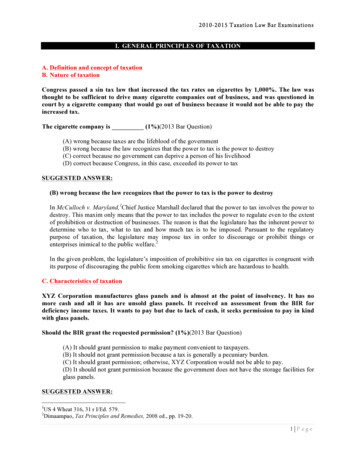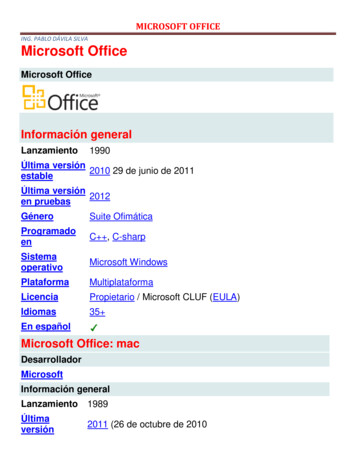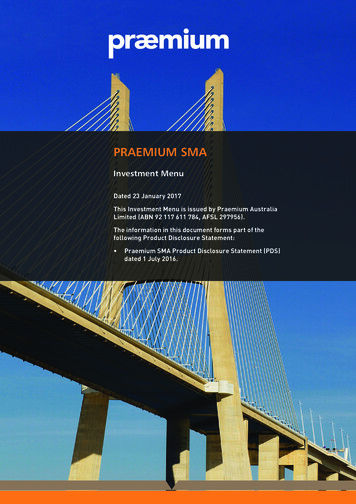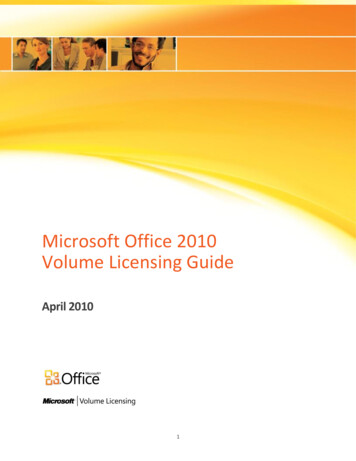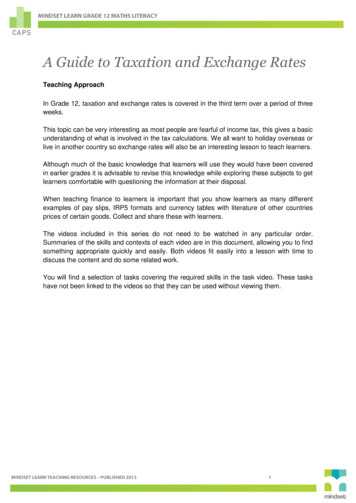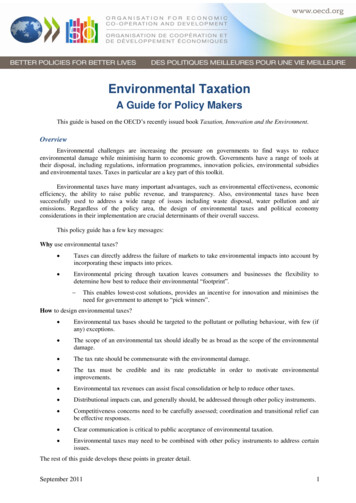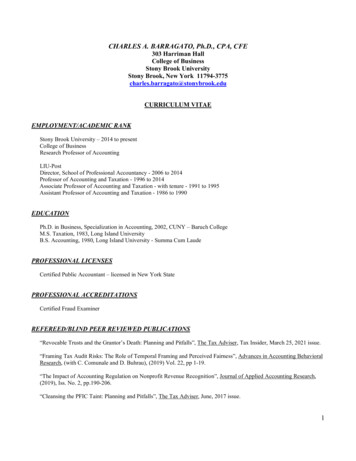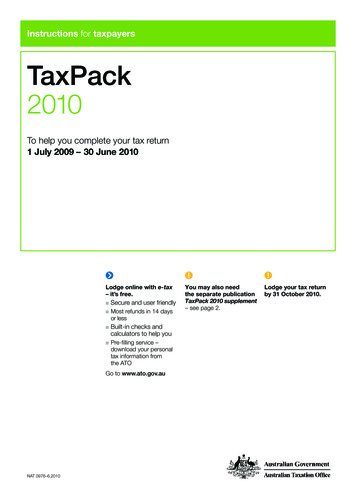
Transcription
Instructions for taxpayersTaxPack2010To help you complete your tax return1 July 2009 – 30 June 2010Lodge online with e-tax– it’s free.nnnnSecure and user friendlyMost refunds in 14 daysor lessBuilt-in checks andcalculators to help youPre-filling service –download your personaltax information fromthe ATOGo to www.ato.gov.auNAT 0976–6.2010You may also needthe separate publicationTaxPack 2010 supplement– see page 2.Lodge your tax returnby 31 October 2010.
Commissioner’s forewordTaxPack 2010 is a guide to help you correctlycomplete your 2010 tax return. We have triedto make it easy to use, and for most people itwill provide all you need to know to fill in yourtax return.Be assured that if you do your best to fill in your taxreturn correctly, you will not be subject to any penaltiesif you get these things wrong.Nevertheless, please take care in ensuring that theinformation you provide to us is as complete andaccurate as you can make it.If you have access to the internet, you can prepareand lodge your tax return online using e-tax. It’s fast,free and easy, and most refunds are issued within14 days. It also provides more extensive informationthan contained in this guide and allows you toautomatically include on your tax return someinformation that we already know about you.We also have a range of services that can assist youwhen completing your tax return. The inside backcover provides details about how you can accessthese services and how you can contact us.Michael D’AscenzoCommissioner of Taxation COMMONWEALTH OF AUSTRALIA 2010This work is copyright. Apart from any use as permitted under theCopyright Act 1968, no part may be reproduced by any processwithout prior written permission from the Commonwealth. Requestsand enquiries concerning reproduction and rights should be addressedto the Commonwealth Copyright Administration, Attorney-General’sDepartment, 3–5 National Circuit, Barton ACT 2600 or posted athttp://www.ag.gov.au/ccaTaxpayers may copy parts of TaxPack 2010 and TaxPack 2010 supplementfor their personal records.Published by the Australian Taxation Office, Canberra, May 2010. Printedby Independent Print Media Group Pty Ltd (IPMG). Distribution coordinatedby Independent Print Media Group Pty Ltd (IPMG) and effected by AustraliaPost and NDD Distribution Pty Ltd.Thanks to the staff of the Tax Office, tax professionals and members ofthe community who contributed to TaxPack 2010.
ContentsWill you need TaxPack 2010 supplement?What’s new this year?Completing Individual information on your tax returnINCOME1 Salary or wages2 Allowances, earnings, tips, director’s fees etc3 Employer lump sum payments4 Employment termination payments (ETPs)5 Australian Government allowancesand payments6 Australian Government pensionsand allowances7 Australian annuities and superannuationincome streams8 Australian superannuation lump sum payments9 Attributed personal services incomeTotal tax withheld10 Gross interest11 Dividends12 Employee share schemesIncome that you show on thesupplementary section of the tax returnTotal income or g deductionsCar and travel expensesD1 Work-related car expensesD2 Work-related travel expensesD3 Work-related clothing, laundry anddry-cleaning expensesD4 Work-related self-education expensesD5 Other work-related expensesD6 Low-value pool deductionD7 Interest deductionsD8 Dividend deductionsD9 Gifts or donationsD10 Cost of managing tax affairsDeductions that you show on thesupplementary section of the tax returnTotal deductionsSubtotal484949LOSSESL1 Tax losses of earlier income yearsTaxable income or loss5054TAXPACK 2010 272829333436394144454647TAX OFFSETSAdjusted taxable income (ATI) for you andyour dependantsT1 Spouse (without dependent child or student),child-housekeeper or housekeeperRebate incomeT2 Senior Australians (includes age pensioners,service pensioners and self-funded retirees)T3 PensionerT4 Australian superannuation income streamT5 Private health insuranceT6 Education tax refundTax offsets that you show on thesupplementary section of the tax returnTotal tax offsetsAdjustments that you show on thesupplementary section of the tax return5558676871727374808181PRIVATE HEALTH INSURANCEPOLICY DETAILS82MEDICARE LEVYM1 Medicare levy reduction or exemptionM2 Medicare levy surcharge8389ADJUSTMENTSA1 Under 18A2 Part-year tax-free thresholdA3 Super co-contribution959697Income testsIT1 Total reportable fringe benefit amountsIT2 Reportable employer superannuationcontributionsIT3 Tax-free government pensionsIT4 Target foreign incomeIT5 Net financial investment lossIT6 Net rental property lossIT7 Child support you paid101101102102102103105106SPOUSE DETAILS – MARRIED OR DE FACTO 107INFORMATIONChecklistHow we work out your taxAmounts that you do not pay tax onDo you need to lodge a tax return?Non-lodgment advice 2010Special circumstances and glossaryImportant informationMore information110110111114116117126inside back cover1
Will you need TaxPack 2010 supplement?You might need TaxPack 2010 supplementwhich contains questions that are not included inTaxPack 2010. Check the list below of questionscovered in TaxPack 2010 supplement to see whetheryou need it to complete your tax return.INCOME13 Income from partnerships and trusts14 Personal services income (PSI)*15 Net income or loss from business*16 Deferred non-commercial business losses*17 Net farm management deposits or withdrawals18 Capital gains* (from all sources including shares,real estate and other property)19 Foreign entities20 Foreign source income and foreign assetsor property, including foreign source pensionor annuity21 Rent22 Bonuses from life insurance companies andfriendly societies23 Forestry managed investment scheme income24 Other income – that is, income not listedelsewhereDEDUCTIONSD11 Australian film industry incentives*D12 Deductible amount of undeducted purchaseprice of a foreign pension or annuityD13 Personal superannuation contributions (generallyfor the self-employed)D14 Deduction for project poolD15 Forestry managed investment scheme deductionD16 Other deductions – that is, deductions notclaimable at items D1 to D15 or elsewhereon your tax return2 TAX OFFSETST7 Superannuation contributions on behalf ofyour spouseT8 Zone or overseas forcesT9 20% tax offset on net medical expenses overthe threshold amount (the threshold for 2010is 1,500)T10 Parent, spouse’s parent or invalid relativeT11 Landcare and water facilityT12 Net income from working – supplementarysectionT13 Entrepreneurs tax offsetT14 Other tax offsetsADJUSTMENTA4 Amount on which family trust distribution taxhas been paidCREDIT FOR INTEREST ON TAX PAIDC1 Credit for interest on early tax paymentsTaxation of financial arrangements(TOFA)F1 Taxation of financial arrangements (TOFA)If you need TaxPack 2010 supplement, you canget a copy from most newsagents from 1 July to31 October 2010. Copies are also available all yearfrom our Publications Distribution Service (see theinside back cover) and shopfronts.Questions marked * have a related publication whichyou must read before you can complete the item onyour tax return.TAXPACK 2010
What’s new this year?Removal of baby bonusYou cannot claim the baby bonus for 2009–10and future years, but you can claim it for past years(2001–02 to 2008–09) for which you have not alreadymade a claim. Depending on your circumstances, youcan lodge a claim (up to 30 June 2014) for the babybonus either:n on the tax return for the relevant year you areclaiming, orn on the relevant approved form.Reforms to some entitlementsYour entitlements could be different this year becausethe law has changed. You might have to completeseven new items on page 8 of your 2010 tax returnand, if you have a spouse, an additional six newitems on pages 9–11.We need this information to assess:n your tax offset entitlementsn your eligibility to certain deductions and taxconcessionsn any Medicare levy surchargen HELP or SFSS repayment amounts.Same-sex couplesFor 2009–10 and future years the definition ofspouse has changed so that your spouse includesanother person (whether of the same sex or oppositesex) who:n you were in a relationship with that was registeredunder a prescribed state or territory law,n although not legally married to you, lived withyou on a genuine domestic basis in a relationshipas a couple.Income earned in overseasemploymentIn most cases you will now include your foreignemployment income in your assessable income,and you may be entitled to a tax offset for the foreigntax you paid on your foreign employment income.Employee share schemesFor 2009–10 and future years, discounts on sharesand rights you acquire under an employee sharescheme will generally be included in your assessableincome in the income year in which you acquire theshares or rights. However, deferral of the tax liabilityis possible in limited circumstances. Question 12deals with these changes.The changes also limit access to the existing taxexemption of up to 1,000 of the total discountsreceived.Taxation of financialarrangements (TOFA)New taxation of financial arrangements (TOFA) ruleshave been introduced to modernise the tax treatmentof financial arrangements.The rules do not apply for 2009–10 unless youmake an election for this to happen.The rules do not generally apply to individuals.The rules are primarily intended for large entitieswith complex financial arrangements. You shouldseek professional advice if you are consideringmaking any elections under these rules.If the TOFA rules apply to you, see ‘Completing thetax return for individuals where the TOFA rules apply’in ‘Taxation of financial arrangements (TOFA)’ availableon our website at www.ato.gov.au/tofaSuper co-contributionsIn order to more accurately assess your super co-contribution entitlements we need to collectenough details on your tax return. This year towork out your entitlements, we will sort amountson your tax return into eligible income, ineligibleincome and assessable income. You may also needto complete A3 (see the instructions on page 97).Your foreign employment income is exemptonly if you earned the income as an aid worker, as a charitable worker, under certain types ofgovernment employment or on projects that are in the national interest.TAXPACK 2010 3
Completing Individual information on your tax returnIt is important that you complete the Individualinformation on pages 1 and 2 of your tax returnaccurately to avoid delaying your notice ofassessment. We have provided explanationsbelow for the tax-related items so that you cancomplete these sections correctly.If you are not sure whether you have to lodge atax return see page 114 for more information.YOUR TAX FILE NUMBERYour tax file number (TFN) is shown on your paymentsummary, as well as on your last notice of assessment.You do not have to quote your TFN on your tax return,but your assessment may be delayed if you do not. Ifyou are new to the tax system and don’t have a TFN,phone the Individual Infoline on 13 28 61.ARE YOU AN AUSTRALIAN RESIDENT?You must print X in the YES box if you were anAustralian resident for tax purposes for all or partof 2009–10. If you were not an Australian residentfor tax purposes during any part of 2009–10 print Xin the NO box.Generally, we consider you to be an Australianresident for tax purposes if:n you have always lived in Australia or you havecome to Australia and live here permanentlyn you have been in Australia continuously for sixmonths or more, and for most of that time youworked in the one job and lived at the same placen you have been in Australia for more than six monthsduring 2009–10, unless your usual home isoverseas and you do not intend to live in Australian you go overseas temporarily and you do not setup a permanent home in another country, orn you are an overseas student who has come toAustralia to study and are enrolled in a coursethat is more than six months long.If you need help in deciding whether or not you arean Australian resident for tax purposes, you can goto the Are you a resident? tool on our website orphone the Individual Infoline.WILL YOU NEED TO LODGE AN AUSTRALIANTAX RETURN IN THE FUTURE?This may be your last tax return if:n your annual taxable income in the future will bebelow the tax-free threshold ( 6,000 for 2010–11)n your only source of income in the future will be anAustralian Government pensionn you will become eligible for the senior Australianstax offset in 2010–11, and your taxable income isbelow the threshold for lodging a tax return this year(for threshold levels and eligibility for 2009–10, seepages 68–70)n you are moving overseas permanently, orn you are 60 years old or older and your only sourceof income is from superannuation benefits (bothlump sum and income streams) that have alreadybeen subject to tax in the superannuation fund.Depending on your situation, print X in the YES, NOor DON’T KNOW box.ELECTRONIC FUNDS TRANSFERFOR YOUR REFUNDIt’s faster and simpler to have your refund paiddirectly into your financial institution account.If you want to use electronic funds transfer (EFT)to receive your tax refund, print X in the YES boxat the question Do you want your refund paiddirectly into your financial institution account?and write the six-digit BSB number, account numberand account name (also called account title) asshown on your account records.Otherwise, print X in the NO box.DECEASED ESTATEPrint DECEASED ESTATE on the top of page 1 ofthe tax return and at the question Will you need tolodge an Australian tax return in the future? print Xin the NO box. The executor or administrator of theestate must sign the tax return on behalf of thedeceased person and send it to us.Has your residency status changed?If your residency status for tax purposes changedduring 2009–10, that is, you were a resident forpart of 2009–10, you will need to answer yes to thisquestion and complete item A2 on page 7 of yourtax return. We need this information to work outyour tax-free threshold.4 TAXPACK 2010
Income 1Salary or wagesThis question is about income from salary or wagesfrom which tax was withheld. Income from salary orwages includes:n salary and wagesn commissionsn bonusesn income from part-time or casual workn amounts for lost salary or wages paid under– an income protection policy– a sickness or accident insurance policy, or– a workers compensation scheme.From 1 July 2009, there have been changes tothe exemption rules for foreign employment income.Show the gross income from your PAYG paymentsummary – foreign employment at this item.ANSWERING THIS QUESTIONYou will need your PAYG payment summary –individual non-business, PAYG payment summary –foreign employment, or a comparable statement suchas a letter or signed statement from each employer orpayer, showing the following details:n gross income (shown as ‘Gross payments’ onyour payment summary)n total tax withheldn foreign tax paid, if applicable, andn the employer’s or payer’s Australian businessnumber (ABN) or withholding payer number (WPN).If you do not have all your payment summariesor comparable statements, contact your employeror payer. If you are unsuccessful in obtainingany of these, more information about makinga statutory declaration is available on our websiteat www.ato.gov.auCompleting Your Tax returnFor the purposes of steps 1 to 5 ‘payment summary’includes comparable statements and statutorydeclarations. Do not combine amounts from differentpayment summaries (unless instructed at steps 5and 6).TAXPACK 2010 Did you earn income from salary or wagesshown on a PAYG payment summary –individual non-business or PAYG paymentsummary – foreign employment?NOGo to question 2.YESRead below.If your PAYG payment summary – individualnon‑business or PAYG payment summary – foreignemployment shows any allowances, include themat item 2 Allowances, earnings, tips, directorsfees etc.Step 1Print the occupation from which you earned most ofyour income from salary or wages under Your mainsalary and wage occupation at item 1.Be as specific as possible when you describe howyou earned your salary and wages, for example,‘insurance clerk’ rather than ‘clerk’, ‘facilitiesmanager’ rather than ‘manager’, ‘bar attendant’rather than ‘student’. For public servants, providework type, for example, ‘call centre operator’.If you have more than five payment summaries,go to step 5.Step 2Write the employer’s or payer’s ABN or WPN fromeach payment summary under Payer’s Australianbusiness number at item 1.Step 3For each PAYG payment summary – individualnon‑business, write the total tax withheld shownon it under Tax withheld at the left of C to G item 1.For each PAYG payment summary – foreignemployment write the total Australian tax withheldshown on it under Tax withheld at the left of C to Gitem 1.5
1 Salary or wagesStep 4Write the gross payment amounts shown on eachpayment summary under Income at C to G item 1.You have now finished this question; go to question 2.Step 5If you have any foreign payment summaries, go tostep 6.Otherwise, follow steps 2 to 4 for your first fourpayment summaries. Then, for your remainingpayment summaries, add up the total tax withheldand write the total at the left of G item 1. Add upthe gross payment amounts and write the total atG item 1. Leave the Payer’s Australian businessnumber for G blank.Step 6Sort your foreign payment summaries from yourAustralian payment summaries.Add up the total Australian tax withheld shown on allyour PAYG payment summary – foreign employmentand write the total at the left of C item 1. Add upthe gross payment amounts and write the total atC item 1. Leave the Payer’s Australian businessnumber for C blank.6 Add up the total tax withheld shown on all yourPAYG payment summary – individual non-businessand write the total at the left of D item 1. Add upthe gross payment amounts and write the total atD item 1. Leave the Payer’s Australian businessnumber for D blank.You may be entitled to a foreign income tax offset,refer to question 20 in TaxPack 2010 supplement forfurther information.HELPFUL HINTSDo not attach your payment summaries andcomparable statements to your tax return.Make sure you keep all your records for five years.A shorter record-keeping period may apply insome situations. More information on recordkeeping and written evidence is available onour website at www.ato.gov.auTAXPACK 2010
Income 2Allowances, earnings, tips,directors fees etcThis question is about payments of income fromworking. These may include:n allowancesn payments from which tax was not withheld,including salary, wages, commissions, bonuses,income earned from part-time and casual jobs,and income from income protection, sickness andaccident insurance policiesn tips, gratuities and payments for your servicesn consultation fees and honoraria – payments forvoluntary services.Allowances include:n car, travel and transport allowances, includingreimbursements of car expenses calculated byreference to the distance travelled by the car, suchas ‘cents-per-kilometre’ allowancesn award transport payments (paid under an industriallaw or award that was in force on 29 October 1986)n tool, clothing and laundry allowancesn dirt, height, site, first aid and risk allowancesn meal and entertainment allowances.ANSWERING THIS QUESTIONYou will need your payment summaries orcomparable statements (or details of the paymentsthat you received if they are not shown on a paymentsummary or comparable statement).If you do not have all your payment summariesor comparable statements, contact your employeror payer. If you are unsuccessful in obtainingany of these, more information about makinga statutory declaration is available on our websiteat www.ato.gov.auIf you received a travel allowance or an overtimemeal allowance paid under an industrial law, awardor agreement you do not have to include it on yourtax return if:n it was not shown on your payment summaryn it does not exceed the Commissioner’s reasonableallowance amount, andn you spent the whole amount on deductibleexpenses.If you choose not to include it you cannot claima deduction for expenses incurred in relation tothat allowance. For more information, see TaxationDetermination TD 2009/15 – Income tax: what arethe reasonable travel and overtime meal allowanceexpense amounts for 2009–10 income year?.Did you receive any of the above payments?NOGo to question 3.YESRead below.Completing Your Tax returnStep 1Add up any tax withheld from these payments.Do not include any amounts of tax withheld youhave shown at other items, such as item 1.Write the amount under Tax withheld at the leftof K item 2.Step 2Add up all of these payments.Do not include any amounts of income you haveshown at other items, such as item 1.Write the amount under Income at K item 2.TAXPACK 2010 7
3 IncomeEmployer lump sumpaymentsThis question is about any lump sum payments youreceived from your employer for unused annual leaveor unused long service leave.Do not include any employer lump sum paymentsin arrears or non-superannuation annuity paymentsin arrears shown at ‘Lump sum E’ on your paymentsummary. These amounts are dealt with at question 24Other income in TaxPack 2010 supplement. Similarly,‘lump sum payments in arrears’ shown on your PAYGpayment summary – superannuation income streamare dealt with at item 7 Australian annuities andsuperannuation income streams.Did you receive any of these payments?NOGo to question 4.YESRead below.Do not include payments for early retirement orgenuine redundancy shown at ‘Lump sum D’ on yourPAYG payment summary – individual non-businessanywhere on your tax return, as they are not taxed.ANSWERING THIS QUESTIONYou will need your PAYG payment summary –individual non-business, PAYG payment summary –foreign employment or a comparable statement fromyour payer showing an amount at ‘Lump sum A’ or‘Lump sum B’ where relevant.If you do not have all your payment summaries orcomparable statements, or if any of your comparablestatements do not show an amount you receivedduring the year that is either a ‘Lump sum A’ ora ‘Lump sum B’ contact your employer or payer. Ifyou are unsuccessful in obtaining any of these, moreinformation about making a statutory declaration isavailable on our website at www.ato.gov.auIf you have received a PAYG payment summary –foreign employment showing an amount at ‘Lumpsum A’ on which foreign tax has been paid you willalso need to include the amount at U in item 20.Completing Your Tax returnIf you do not have any amounts shown at ‘Lumpsum A’ on your payment summaries, go to step 4.Amounts shown at ‘Lump sum A’ onyour payment summaryStep 1Add up the total tax withheld from lump sum Aamounts shown on your payment summaries. Do notinclude any amounts of tax withheld you have includedat any other item, such as item 1 or 2.Write the answer under Tax withheld at the leftof R item 3.Step 2Add up all lump sum A amounts on your paymentsummaries.Write the answer at R item 3.8 Step 3Print in the TYPE box at the right of R:R if the amount related to a genuine redundancypayment, an early retirement scheme payment,or the invalidity segment of an employmenttermination payment or superannuation benefitT for all other situations.Check with your payer if you are not sure.If you do not have any amounts shown at ‘Lumpsum B’ on your payment summaries, you havefinished this question. Go to question 4.Amounts shown at ‘Lump sum B’ onyour payment summaryStep 4Add up the total tax withheld from lump sum B amountsshown on your payment summaries. Do not include anyamounts of tax withheld you have included at step 1above or at any other item, such as item 1 or 2.Write the answer under Tax withheld at the left of Hitem 3.Step 5Add up all lump sum B amounts on your paymentsummaries.Divide the total by 20 to work out 5% of the amounts.Only 5% of these amounts is taxable.Write the answer at H item 3.MORE INFORMATIONFor more information, go to our website at www.ato.gov.au and enter ‘Lump sum payments’in the ‘Search for’ box at the top of the page.TAXPACK 2010
Income 4Employment terminationpayments (ETPs)This question is about employment terminationpayments (ETPs), which you received as a resultof the termination of your employment.These payments are shown on a PAYG paymentsummary – employment termination payment.This item also includes:n death benefit ETPs – these are certain paymentsmade as a consequence of the cessation of aperson’s employment that you received due to thatperson’s death (see page 124 for more information)n foreign ETPs – these are certain ETPs receivedfrom overseas employment which were exemptfrom income tax under that country’s law (seepage 117 for more information)n late termination payments – these are certainETPs you received more than 12 months afteryou retired or ceased employment (see page 124for more information)n transitional termination payments – these arecertain ETPs you were entitled to on 9 May 2006(see page 124 for more information).Do not show the following payments anywhereon your tax return:n foreign termination payments – these are certaintermination payments that were not exempt fromincome tax of the foreign country (see page 123for more information)n directed termination payments – these aretransitional termination payments that can,at your request, be paid by your employer toa complying superannuation fund or to purchasea superannuation annuityn ETPs you received as the trustee of a deceasedestate (these payments must be shown on thetrust tax return of the deceased estate).Did you receive an ETP?NOGo to question 5.YESRead below.ANSWERING THIS QUESTIONYou will need your PAYG payment summary –employment termination payment.Completing Your Tax returnIf you received two or more ETPs, go to step 5.Otherwise, read on.If you do not have all your payment summaries,contact your employer or payer. If you areunsuccessful in obtaining any of these, moreinformation about making a statutory declarationis available on our website at www.ato.gov.auStep 1Write in the left column at item 4 the date of paymentand your payer’s Australian business number (ABN),as shown on your PAYG payment summary –employment termination payment.If you have received a foreign ETP, your foreignemployer may not have issued you with a PAYGpayment summary – employment terminationpayment. See page 117 for further instructions.For information about late termination payments,transitional termination payments, foreigntermination payments, directed terminationpayments and death benefits dependants,see pages 123–5.TAXPACK 2010 Step 2Write the total amount of tax withheld from yourETP, as shown on your PAYG payment summary –employment termination payment, under Tax withheldat the left of I item 4.9
4 Employment termination payments (ETPs)Step 3Write the taxable component of your ETP, as shownon your PAYG payment summary – employmenttermination payment, at I item 4.Step 4Print the appropriate code letter for the paymenttype in the TYPE box at the right of I on your taxreturn. If none of the following apply to you, leavethe box blank.T if you received a transitional termination paymentS if you received an ETP in 2009–10 that was nota transitional termination payment or a deathbenefit ETP and you had received another suchETP in an earlier income year for the sametermination of employmentD if you received a death benefit ETP and you werea death benefits dependantB if you received a death benefit ETP in 2009–10and you were not a death benefits dependant andyou had received another death benefit ETP inan earlier income year for the same terminationof employmentN if you received a death benefit ETP and you werenot a death benefits dependant, and code B doesnot apply.You have now finished this question, go to question 5.10 Step 5If you received two or more ETPs, you need tocomplete an Employment termination paymentschedule (NAT 71744) using the information shownon your payment summaries. You can obtain a copyof the schedule from our website or by phoningour Individual Infoline (see the inside back cover).Step 6When you have completed the schedule, transferthe totals you have written on it to item 4 on yourtax return. Write the total tax withheld underTax withheld at the left of I, write the total taxablecomponent at I, and print the code letter M in theTYPE box.Do not write any date of payment or payer’s ABNon your tax return.Step 7Attach your schedule to page 3 of your tax returnand print X in the YES box at Taxpayer’s declarationquestion 2a on page 12 of your tax return.More informationFor more information on ETPs, read Employmenttermination payments (NAT 70643) and Employmenttermination payments – transitional arrangements(NAT 70644).TAXPACK 2010
Income 5Australian Governmentallowances and paymentsThis question is about the following AustralianGovernment payments:n parenting payment (partnered)n Newstart allowancen youth allowancen mature age allowancen partner allowancen sickness allowancen special benefitn widow allowancen Austudy paymentn exceptional circumstances relief paymentn interim income support paymentn education payment of any of the following whenyou were 16 years old or older– ABSTUDY living allowance– payment under the Veterans’ ChildrenEducation Scheme– payment under the Military Rehabilitation andCompensation Act Education and TrainingScheme 2004 – shown as ‘MRCA EducationAllowance’ on your PAYG payment summary –individual non-businessANSWERING THIS QUESTIONYou will need:n your PAYG payment summary – individualnon‑business, orn a letter from the agency that paid your allowanceor payment stating the amount you received.If you have not received this information or you havelost it, contact the agency that paid you.Completing Your Tax returnStep 1Add up the tax withheld shown on each of yourpayment summaries and letters.nnnnother taxable Commonwealth education ortraining paymentsincome support component from a
1 July 2009 - 30 June 2010 Lodge online with e-tax - it's free. n Secure and user friendly n Most refunds in 14 days or less n Built-in checks and calculators to help you n Pre-filling service - download your personal tax information from the ATO Go to www.ato.gov.au You may also need the separate publication TaxPack 2010 supplement .

